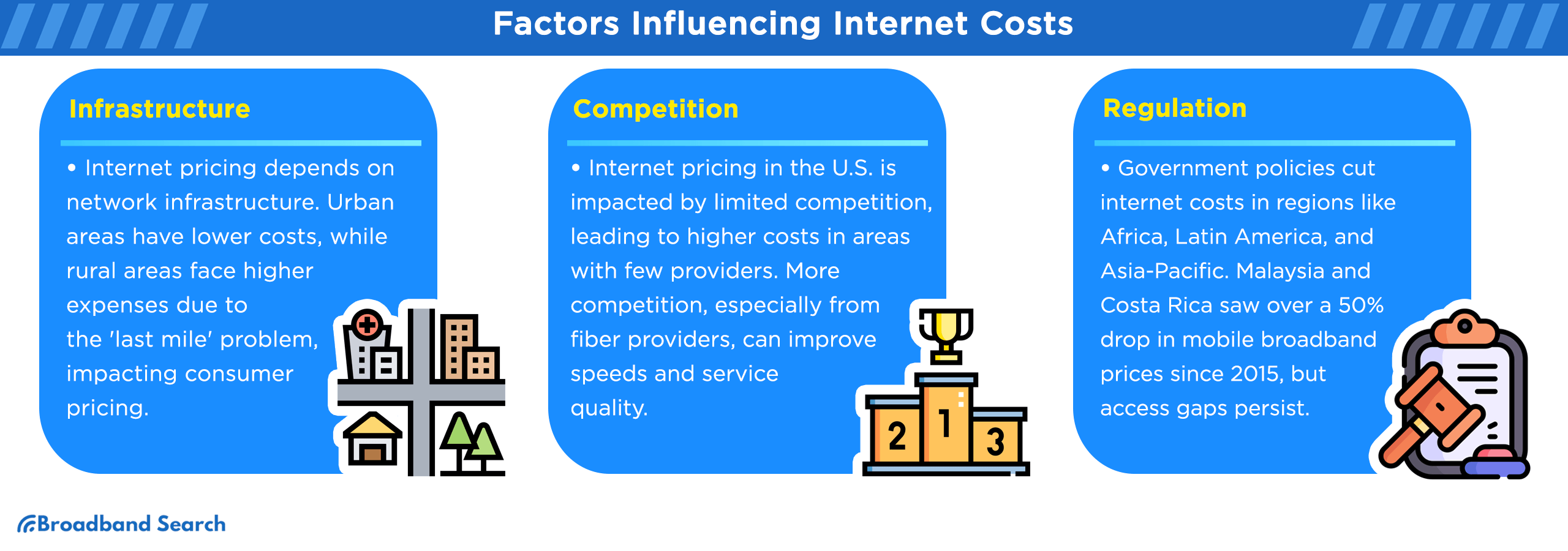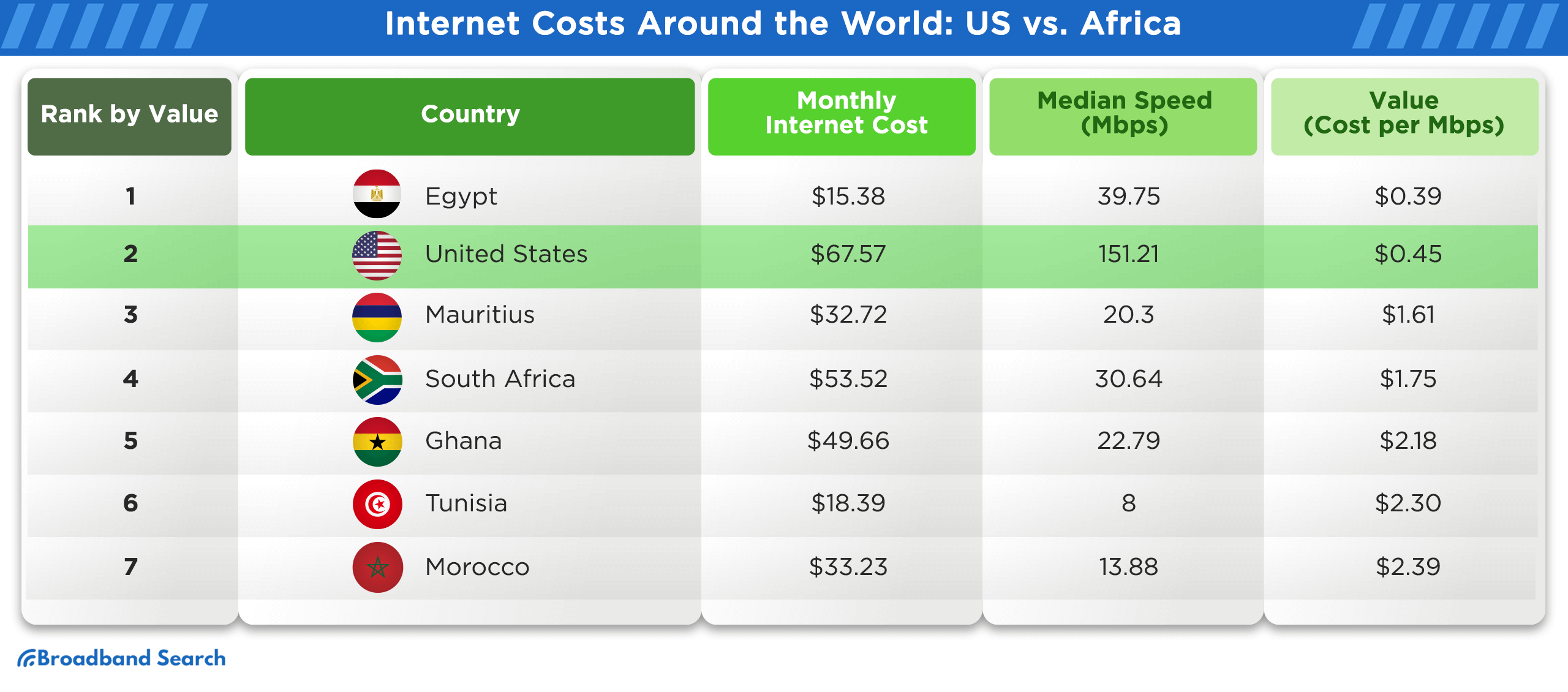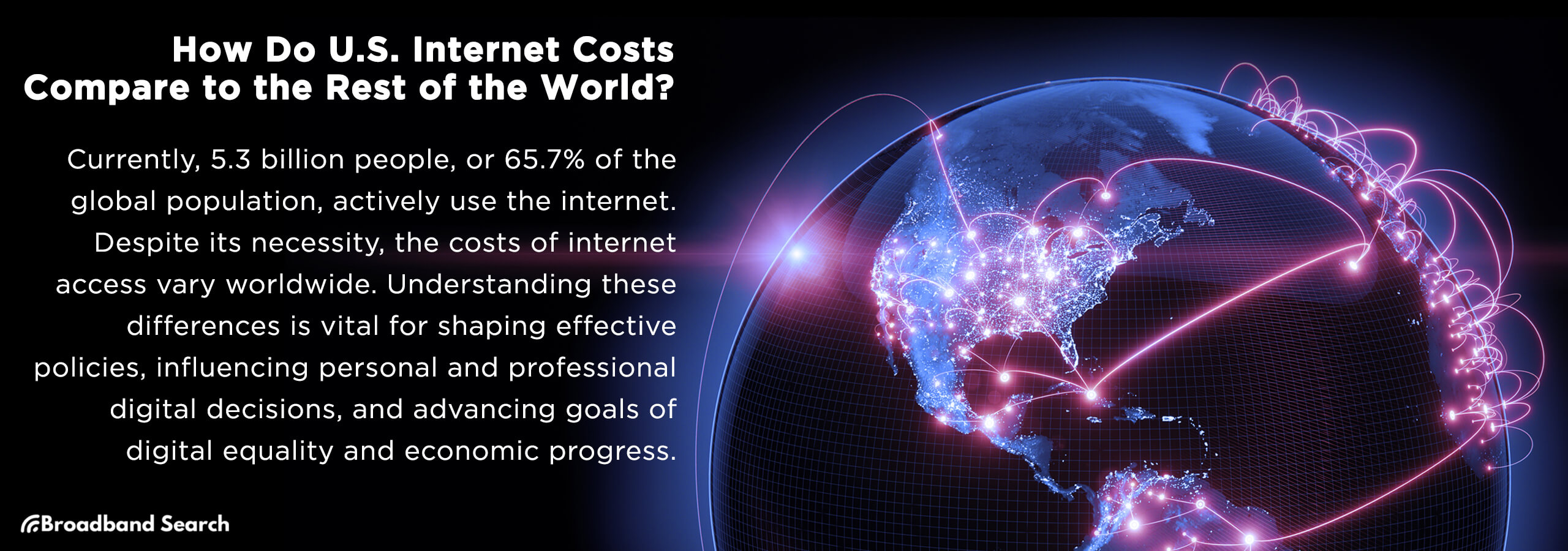Today, approximately 5.18 billion internet users globally, including you, are actively engaged online, making up 64.6 percent of the total global population. The internet has become a necessity for many. And yet the costs of accessing it aren’t equal around the world.
Your understanding of these cost differences is crucial. It illuminates the varying degrees of digital access across nations, aids in shaping effective internet policies, and directly impacts your decisions in both personal and professional digital realms. This knowledge is not just a metric of current global internet accessibility but a stepping stone towards achieving broader goals of digital equality and economic progress.
U.S. Internet Costs: An Overview
Average Cost of Internet in the U.S.
Forbes outlines the diverse internet service options and their average costs: DSL at $50/month for slower speeds, widely available cable at $65/month for faster speeds, exceptionally fast but less accessible fiber at $67/month, and satellite for remote areas with slower speeds at a higher $90/month.
- DSL: $50/month, slower speeds, widely available
- Cable: $65/month, faster speeds, widely available
- Fiber: $67/month, exceptionally fast, less accessible
- Satellite: $90/month, slower speeds, for remote areas
When compared with the U.S. average household income in 2023, estimated around $106,270.90, it's clear that internet service costs generally represent a small fraction of total income for many American households. However, the relative financial impact of these expenses varies significantly, depending on a household's income level and the specific internet plan chosen.
Factors Influencing Internet Costs

Infrastructure
Network infrastructure is a key determinant of internet pricing. The cost of building and maintaining infrastructure, especially in less accessible or less densely populated areas, can significantly influence costs.
Urban areas, where infrastructure is more developed and densely packed, generally see lower internet costs. In contrast, rural areas face higher costs due to the "last mile" problem, where extending services to less populated regions is more expensive and complex. This urban-rural divide directly impacts consumer pricing.
Competition
The impact of market competition on internet pricing is significant. In the U.S., more than 200 million residents live in areas with only one or two reliable high-speed internet providers, leading to higher prices than markets with more options.
Entry of new competitors into broadband markets has been limited, with minimal increases in the number of internet providers in both urban and rural areas. However, increased competition, particularly from fiber providers, has been associated with higher internet speeds and potentially better service quality.
Regulation
Government policies significantly influence internet costs. Effective national broadband plans, highlighted in the A4AI 2020 Affordability Report, have led to more affordable internet, particularly in regions like Africa, Latin America, and Asia-Pacific. Countries with strong policies, such as Malaysia and Costa Rica, have seen substantial price reductions.
These policies have resulted in a more than 50 percent reduction in mobile broadband prices since 2015. Yet despite these improvements, disparities in access remain, with many still lacking basic internet connectivity.
Trends Over the Past Decade
Price Trends in the U.S.
Over the past decade, the U.S. has seen a notable trend in declining broadband internet prices. According to the USTelecom Broadband Pricing Index (BPI), there have been substantial reductions in the prices of both the most popular and highest-speed broadband internet services. This trend is significant, especially given the overall price inflation in other sectors of the U.S. economy during the same period.
From 2021 to 2022, real BPI-Consumer Choice broadband prices dropped by 14.7 percent, and BPI-Speed broadband prices decreased by 11.6 percent. When looking at a longer-term perspective (2015 to 2022), the reduction is even more dramatic: Real BPI-Consumer Choice tier prices decreased by 44.6 percent. BPI-Speed tier prices decreased by 52.7 percent.
Additionally, internet providers have increased the speeds of their offerings. This increase in speed, coupled with the price drop, has led to the cost per megabit of both popular and fastest service offerings dropping by about 75 percent since 2015.
Technological Advancements and Their Impact on Internet Pricing
Technological advancements significantly impact internet pricing and are poised to continue shaping its future. Key tech trends like cloud computing, 5G, AI, machine learning, and low-code development platforms are accelerating the primary characteristics of the digital era: granularity, speed, and scale. These innovations have increased compute power, network speeds, and analytical sophistication, leading to new businesses and models.
By 2025, it's estimated that 50 billion devices will be connected to the Industrial Internet of Things (IIoT), and a significant portion of new applications will use low-code/no-code (LC/NC) technologies. This technological proliferation is expected to bring more progress in the next decade than in the past century.
Global Perspective: Internet Costs Around the World
US vs. Europe
Here's the data organized in a table format, comparing internet costs, speeds, and value in the United States and various European countries:

Factors Contributing to Lower Costs
The lower costs of internet in Europe compared to the United States can be attributed to several factors:
- Regulated Competition and Government Subsidies: European Union member states have actively worked towards universal broadband with financing initiatives and regulated markets promoting competition through open access infrastructure. This approach has led to more affordable broadband services across Europe.
- Cost Structures and Urbanization: The cost of deploying broadband in Europe is typically lower due to higher urbanization rates and population densities. Dense urban areas are cheaper to connect (at least per person or household) than rural areas. The United States, with more suburban and rural areas, faces higher deployment costs.
US vs. Asia
Let’s compare internet service costs and value between the United States and countries in Asia.

High-Speed Internet in Asia
In Asia, the focus on technological innovation and infrastructure has spurred significant growth in the tech sector and digital services.
- Technological Dominance: Asia has become a significant technological force, contributing 52 percent to global tech-company revenues, 43 percent of startup funding, 51 percent of R&D spending, and 87 percent of patents filed. This growth is partly attributed to well-developed infrastructure, government collaborations with local tech companies, and advanced goals in fields like renewable energy and AI.
- Infrastructure and Development: Asian countries, including South Korea, have capitalized on their robust infrastructure for 5G development and deployment, with four out of the five leading 5G patent holders being Asian firms. The region's strong position in next-generation electric-vehicle batteries and other tech sectors also stems from leveraging existing strengths.
- Digital Services Expansion: The region is poised to expand its role in digital IT services, such as big data, analytics, and IoT system design, bolstered by a vast pool of tech talent. For instance, India alone produced three-quarters of the world's STEM graduates between 2016 and 2018.
US vs. Africa
Here's the comparison of internet costs in the United States and various African countries, organized by value (cost per Mbps) and including the ranking:

The challenges of internet accessibility in Africa compared to the United States are significant and multifaceted. In Africa, the cost of the internet is a major impediment, as it is the most expensive in the world. Africans pay on average 8.8 percent of their monthly income for 1GB of data, which is substantially higher than the percentages in Latin America (3.6 percent) and Asia (1.5 percent).
Achieving universal, affordable internet in Africa by 2030 requires a $100 billion investment, with 80 percent for network infrastructure and 20 percent for user skills, content, and regulatory frameworks. Less than a third of Africans have broadband access, highlighting the need for extensive network development.
Sub-Saharan Africa faces a 19 percent coverage gap, indicating many without mobile broadband. To connect 100 million in remote areas, innovative solutions like satellite and Wi-Fi technologies, alongside private sector participation, are essential. For example, the integration of satellite technology with cloud computing and analytical tools is facilitating the democratization of data innovation in Africa. This combination is empowering governments and aiding in the journey towards sustainable growth, inclusivity, and economic prosperity.
Internet Costs in The Americas
- United States: According to Numbeo, the average cost of a broadband internet connection in the United States is $71.49. This places the U.S. among the top ten most expensive countries for internet in Latin America and the Caribbean. When considering the price per megabyte (MB), the U.S. appears cheaper due to its higher average internet speeds compared to other countries in the region.
- North America: The United States ranks 5th globally in terms of internet cost (60 Mbps or more, unlimited data, cable/ADSL) with an average price of $71.49. Canada follows at 6th with $64.09, and Puerto Rico is 7th at $62.61.
- Caribbean and Central America: In the Caribbean and Central America, internet costs vary. Costa Rica ($48.52), Panama ($47.21), and Jamaica ($45.19) are among the countries with higher costs, while others like Ecuador ($37.75) have lower costs.
- South America: In South America, the cost of the internet also varies widely. Mexico ($29.96), Peru ($29.36), Chile ($25.29), and Colombia ($24.45) represent countries with lower internet costs compared to the U.S. However, Brazil ($20.81) and Argentina ($18.38) have even more affordable rates.
This comparison indicates that while the United States has one of the higher internet costs in the Americas, several countries in the Caribbean and Central America, such as Costa Rica, Panama, and Jamaica, also have relatively high internet costs. South American countries, in contrast, generally have lower internet costs, with Brazil and Argentina offering some of the most affordable rates in the region.
These differences in internet costs can be attributed to various factors, including infrastructure development, market competition, regulatory environments, and economic conditions in each country.
Internet Cost vs. Speed and Quality
Analysis of Cost-Speed-Quality Correlation
Internet Costs
When discussing internet costs globally and in the United States, the competition among Internet Service Providers (ISPs) plays a crucial role in determining these costs. Globally, monthly internet bills typically range from about $20 to just over $50. However, there are significant regional variations. The United States ranks sixth worldwide in terms of the highest average internet cost, at $67.57 per month.
In contrast, countries like Ukraine, Russia, Romania, Turkey, Moldova, India, and Sri Lanka offer internet services for less than $10 monthly. Europe and Asia are well-represented among the ten cheapest countries for internet services. When considering internet speed, Romania is notable for offering internet at just $0.06 per month per Mbps, part of an average monthly bill of just $8.25. In comparison, the United States' average cost is $0.45 per month per Mbps.
Internet Speed
Taiwan leads with an impressive speed of 153.51 Mbps, closely followed by France at 152.45 Mbps.
The Netherlands and Slovakia also demonstrate high internet speeds, at 142.49 Mbps and 138.03 Mbps respectively, showcasing Europe's strong digital infrastructure. The United States, with an average speed of 136.48 Mbps, while high, doesn't top the list.
Quality Considerations
Quality of internet service can be inferred from speed and cost metrics. Countries offering high speeds at lower costs likely provide better overall internet quality. For instance, Romania stands out for its combination of low cost and high speed. On the other hand, the United States, while offering relatively high speeds, does so at a higher cost, which might impact the perceived quality of service.
The United States ranks relatively high in both internet cost and speed but falls behind some smaller countries and certain European and Asian nations that offer faster speeds at lower costs.
The Role of Government and Regulation
Government Policies and Their Impact on Internet Costs
The U.S. government has allocated significant funds to enhance internet access and infrastructure. The 2021 infrastructure law authorized $42 billion to make high-speed broadband universally accessible by 2030. This includes funding for rural areas and states with substantial gaps in broadband access.
Since 2019, the USDA's ReConnect program has distributed over $1.5 billion in grants and loans to broadband providers, aiming to encourage the expansion of services in rural communities. Additionally, the NTIA manages two distinct grant programs focused on enhancing broadband access in tribal areas, further supporting federal efforts to improve connectivity in various regions.
Approximately 8.5 million locations in the U.S. still lack broadband connections, with broadband companies hesitant to invest in low-population, rural areas due to high costs and fewer subscribers.
Recent policy developments and world events, influenced by the COVID-19 pandemic, have emphasized the need for widespread broadband adoption. Major bills like the Consolidated Appropriations Act and the Infrastructure Investment and Jobs Act have provided substantial funding for broadband infrastructure, focusing on closing the remaining access gaps.
Final Thoughts
The comparison between the USA and various regions, including Asia and Europe, reveals notable differences in internet costs, speeds, and values. Asian countries, particularly high-speed hubs like South Korea and Japan, offer remarkable value in terms of cost per Mbps, outperforming the USA in affordability.
For policymakers in the United States, these findings suggest a need to focus on enhancing digital infrastructure and fostering competition to improve internet affordability and speed. For consumers, the evolving landscape offers hope for more accessible and cost-effective internet services, ideally reducing the digital divide.
FAQ
How do bundling services (like cable, phone, and internet) affect overall internet costs in the U.S. compared to standalone services?
Bundling services in the U.S. often reduce overall internet costs compared to standalone services. Providers offer discounts for combining cable, phone, and internet, making it a cost-effective option for many consumers. However, consumers should only bundle services they actually plan on using.
What impact has the COVID-19 pandemic had on internet costs and usage patterns in the U.S. and globally?
The COVID-19 pandemic has led to increased bandwidth usage in the U.S. and globally, resulting in higher costs for some due to upgraded plans. However, some providers offered temporary relief measures to ease financial burdens during the crisis.
How does the availability of public Wi-Fi and its costs in the U.S. compare with other countries?
Public Wi-Fi availability in the U.S. varies but is generally widespread. Costs can vary, but many businesses offer free Wi-Fi to customers. In comparison to some countries, the U.S. has reasonably accessible and affordable public Wi-Fi, especially in metropolitan areas.
What is the average contract length for internet services in the U.S. compared to other countries?
The average contract length for internet services in the U.S. typically ranges from 1 to 2 years. This duration can vary by provider and plan. In some other countries, shorter contracts or pay-as-you-go options may be more common.
How does the reliability and uptime of internet services in the U.S. compare with those in other nations?
The reliability and uptime of internet services in the U.S. are generally high, with occasional regional disruptions. Comparatively, the U.S. often maintains a robust infrastructure, but some countries may have even higher levels of internet reliability.

